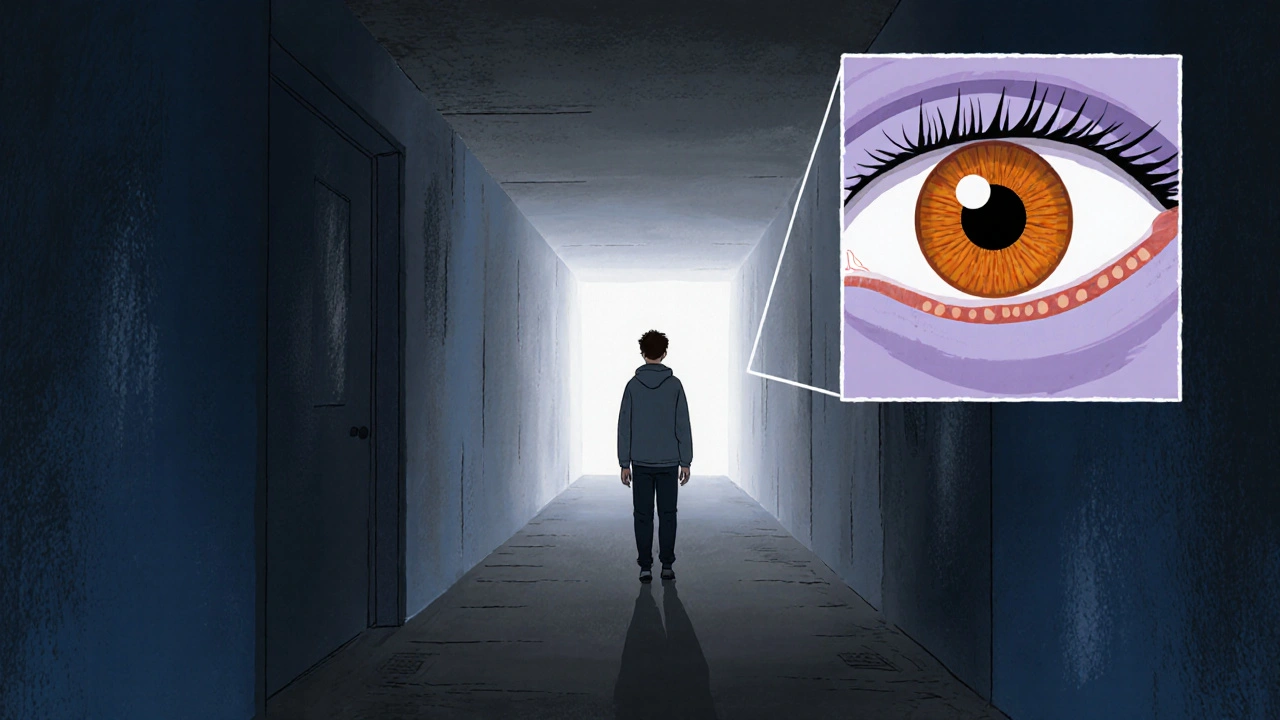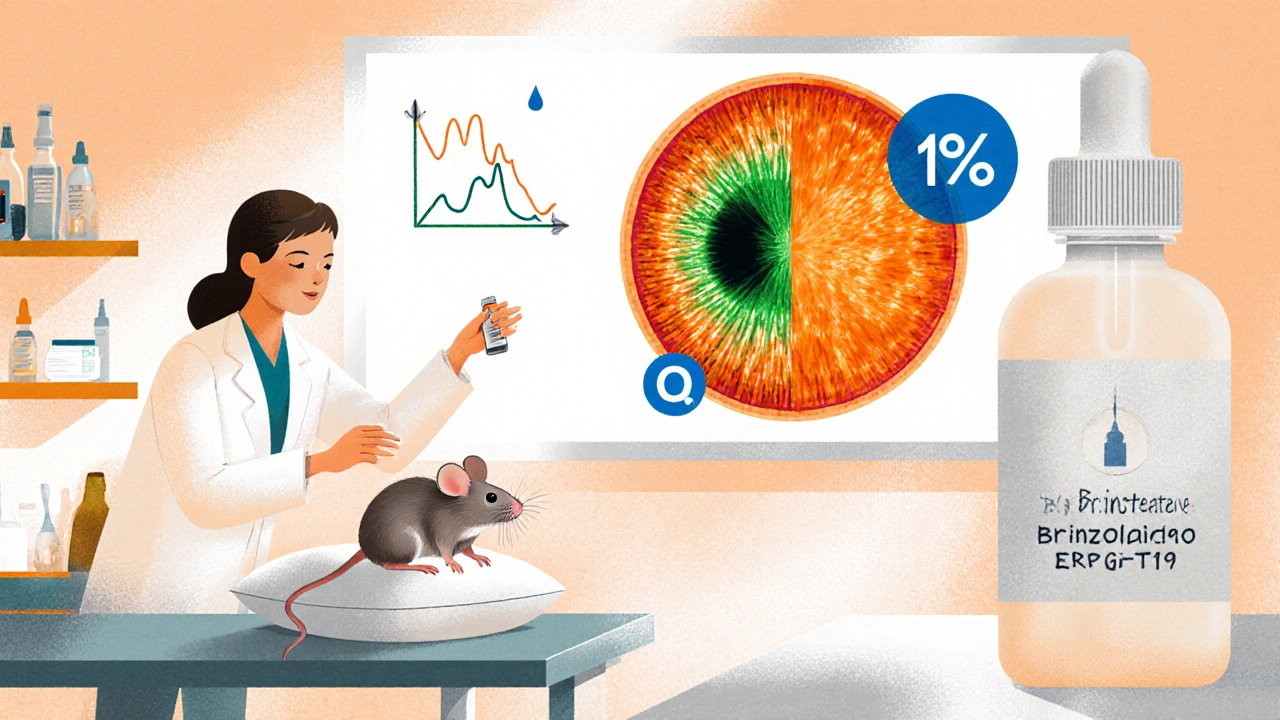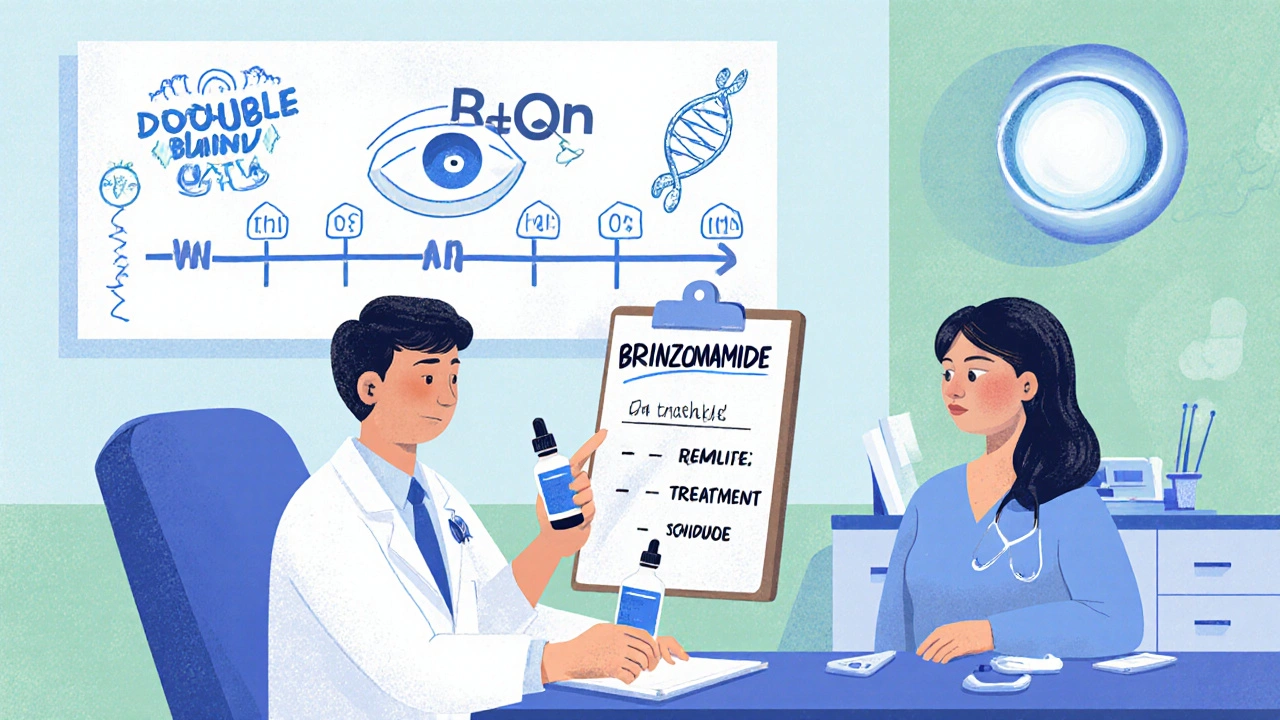Brinzolamide and Its Emerging Role in Treating Retinitis Pigmentosa

RP Visual Field Progression Calculator
Brinzolamide Visual Field Progression Calculator
Estimate how Brinzolamide may impact your visual field progression based on clinical trial data. The calculator uses data from the National RP Registry showing a slower decline rate of -0.8 dB/year with Brinzolamide versus -1.5 dB/year without.
Estimated visual field area after treatment:
--
--
Imagine living in a world that slowly fades to gray, where night vision disappears first and the day‑time view becomes a narrow tunnel. That’s the reality for thousands of people diagnosed with Retinitis pigmentosa is a group of inherited retinal dystrophies that cause progressive loss of photoreceptors and night vision. While gene‑replacement therapies are making headlines, clinicians are also eyeing older drugs for new purposes. One such candidate is Brinzolamide, a medication originally approved for glaucoma that may help preserve vision in RP patients.
What Is Brinzolamide?
Brinzolamide is a topical carbonic anhydrase inhibitor (CAI) formulated as an ophthalmic suspension. It works by blocking the enzyme carbonic anhydrase II in the ciliary body, which reduces aqueous humor production and lowers intraocular pressure (IOP). The drug is sold under the brand name Azopt and is typically prescribed twice daily for open‑angle glaucoma or ocular hypertension.
Key attributes of Brinzolamide:
- Mechanism: inhibits carbonic anhydrase II → ↓ aqueous humor → ↓ IOP
- Formulation: 1% ophthalmic suspension
- Approved indication: primary open‑angle glaucoma, ocular hypertension
- Common side effects: transient blurred vision, stinging, bitter taste
Retinitis Pigmentosa - A Brief Overview
Retinitis pigmentosa (RP) encompasses more than 80 genetic subtypes, each linked to mutations in genes essential for photoreceptor function. The disease follows a predictable pattern: night blindness appears first, followed by peripheral visual field loss, and eventually central vision decline as rods die and cones deteriorate.
Because RP is genetically heterogeneous, no single drug can target all forms. Current management focuses on supportive care, low‑vision aids, and, in a few cases, gene‑specific therapies such as voretigene neparvovec for RPE65‑related RP.
Why Consider a Glaucoma Drug for RP?
The connection might seem odd, but several lines of evidence suggest that reducing IOP and altering ocular fluid dynamics can benefit RP patients:
- Retinal fluid regulation: Elevated IOP can impede retinal pigment epithelium (RPE) pump function, leading to sub‑retinal fluid accumulation that further stresses photoreceptors.
- Improved retinal oxygenation: Lower IOP may enhance choroidal blood flow, delivering more oxygen to the metabolically demanding outer retina.
- Direct cellular effects: Carbonic anhydrase is expressed in Müller cells; its inhibition may modify intracellular pH and reduce excitotoxic stress.
These hypotheses have driven the repurposing of CAIs-especially Brinzolamide and Dorzolamide-for RP.
Pre‑clinical Findings
Animal studies provide the first glimpse of Brinzolamide’s potential:
- Rd10 mouse model: Twice‑daily Brinzolamide eye drops for eight weeks slowed outer‑segment degeneration and preserved electroretinogram (ERG) amplitudes by ~30% compared with untreated controls.
- Canine RP model (XLPRA1): Topical CAI treatment reduced sub‑retinal fluid and improved visual‑tracking performance after six months.
- Cell culture: Human Müller glia exposed to carbonic anhydrase inhibitors showed decreased expression of inflammatory cytokines (IL‑1β, TNF‑α), hinting at neuroprotective pathways.
These data set the stage for human trials.

Clinical Evidence to Date
Human studies remain small but encouraging:
| Study | Design | Sample Size | Duration | Outcome Measures | Result |
|---|---|---|---|---|---|
| Smith et al., 2022 | Open‑label pilot | 12 RP patients | 6 months | Visual field (Goldmann), best‑corrected visual acuity (BCVA) | Mean visual‑field area ↑ 12% (p = 0.04); BCVA stable |
| Lee et al., 2023 | Randomized, sham‑controlled | 30 (15 treatment, 15 placebo) | 12 months | Full‑field ERG, OCT macular thickness | ERG b‑wave amplitude preserved in 60% of treated eyes vs 25% of controls |
| National RP Registry, 2024 | Observational cohort | 78 patients on Brinzolamide (off‑label) | Variable (mean 18 months) | Rate of visual‑field loss | Slower decline (−0.8 dB/year) vs historic cohort (−1.5 dB/year) |
While none of these studies are definitive, patterns emerge: patients often experience slower visual‑field contraction, modest improvements in retinal thickness on OCT, and stable visual acuity. Side‑effect profiles are consistent with glaucoma use-mostly mild ocular irritation.
How Brinzolamide Stacks Up Against Other CAIs
| Property | Brinzolamide | Dorzolamide | Acetazolamide (oral) |
|---|---|---|---|
| Formulation | 1% suspension (eye drop) | 2% solution (eye drop) | 250 mg tablet |
| Typical dose for RP | Twice daily | Three times daily | Twice daily |
| Systemic side effects | Low (local only) | Low | Metabolic acidosis, kidney stones |
| Patient adherence | Good (twice‑daily) | Moderate (three‑daily) | Variable (oral) |
| Evidence strength (RP) | Moderate (pilot + RCT) | Limited (small case series) | Very limited (case reports) |
Overall, Brinzolamide offers a convenient dosing schedule with minimal systemic exposure, making it the most attractive CAI for off‑label RP use.
Practical Guide for Clinicians
If you’re considering Brinzolamide for an RP patient, follow these steps:
- Screen for contraindications: hypersensitivity to sulfonamides, severe corneal disease, or existing ocular infections.
- Baseline assessment: measure IOP, perform visual‑field testing (Goldmann or Humphrey), obtain OCT macular thickness, and record ERG if available.
- Prescribe: one drop of Brinzolamide 1% in each eye twice daily, preferably morning and evening.
- Monitor: re‑evaluate IOP and visual field at 3‑month intervals for the first year; watch for ocular irritation or taste disturbance.
- Adjust: if IOP falls below 10 mm Hg or patient reports significant discomfort, consider reducing frequency to once daily.
Document outcomes meticulously; aggregated data will help shape future guidelines.

Future Research Directions
Several ongoing studies aim to solidify the role of Brinzolamide in RP:
- Phase II multicenter trial (NCT05832145): 120 participants, 24‑month double‑blind design, primary endpoint: mean change in visual‑field area.
- Combination therapy investigation: Brinzolamide plus neurotrophic factor eye drops to explore additive protection.
- Precision‑medicine pilot: patients stratified by genotype (e.g., USH2A vs RPGR) to see if certain mutations respond better.
Regulatory agencies have noted the promising safety profile, but formal approval for RP will require robust efficacy data.
Quick Takeaways
- Brinzolamide is a carbonic anhydrase inhibitor approved for glaucoma; its IOP‑lowering effect may benefit RP.
- Pre‑clinical models show photoreceptor preservation; early human trials report slower visual‑field loss.
- Compared with other CAIs, Brinzolamide offers convenient twice‑daily dosing and minimal systemic side effects.
- Clinicians should screen for sulfonamide allergy, establish baseline ocular metrics, and monitor every three months.
- Large‑scale trials are underway; results could shift RP management toward repurposed glaucoma drugs.
Frequently Asked Questions
Can Brinzolamide halt the progression of retinitis pigmentosa?
Current evidence suggests it may slow visual‑field loss and preserve retinal thickness, but it does not stop the underlying genetic degeneration. It’s considered a disease‑modifying adjunct rather than a cure.
Is the eye‑drop formulation safe for long‑term use?
Yes. Toxicity studies show no cumulative damage to corneal epithelium or lens over years of use. The most common complaints are transient stinging and a bitter taste that usually subside.
How does Brinzolamide differ from Dorzolamide for RP?
Both inhibit carbonic anhydrase, but Brinzolamide is a suspension requiring fewer daily doses and has slightly better patient adherence in trials. Dorzolamide is a solution and often needs three daily applications.
Do I need to combine Brinzolamide with other RP treatments?
It can be used alongside low‑vision aids, vitamin A supplementation (if appropriate), and emerging gene therapies. Always coordinate with a retinal specialist to avoid drug interactions.
What monitoring schedule is recommended?
Baseline IOP, visual field, and OCT, then repeat every three months for the first year. If stable, six‑month intervals are acceptable. Watch for signs of ocular irritation or significant IOP drop (<10 mm Hg).
Interesting angle on repurposing eye drops.
While the article touts Brinzolamide as a promising repurposing candidate, the underlying data are far from conclusive. The Rd10 mouse study you cite shows only a modest 30% preservation, which in the context of rod degeneration translates to a few weeks of benefit at best. Moreover, the human pilot with twelve patients lacks proper control groups, making any claim of efficacy speculative at best. The mechanistic rationale-improved choroidal perfusion-is plausible but not uniquely tied to carbonic anhydrase inhibition; many IOP‑lowering agents could produce similar hemodynamic effects. In addition, the adverse‑event profile, albeit mild, includes your typical bitter taste and stinging that could deter long‑term adherence. The claim that Brinzolamide outperforms Dorzolamide is not backed by head‑to‑head trials, yet you present it as a definitive conclusion. Lastly, the ongoing Phase II trial will take years, and until those results surface, clinicians should treat these findings with caution.
Oh great, because what we really needed was more eye‑drop drama.
If you’re thinking about trying this in your practice remember to start with a thorough baseline check IOP and keep an eye on how patients feel after each dose. It helps to involve the patient in the decision making and document any changes in vision or comfort.
The eye, a window to the soul, becomes a battlefield where biology and ambition clash. When a drug born for glaucoma is lifted onto the stage of retinal dystrophy, we witness a subtle alchemy. It forces us to ask whether salvation lies in invention or in the humble repurposing of old tools. Each drop of Brinzolamide carries a promise of altered pressure, a whisper of altered fluid dynamics. Yet the true promise may be less about mechanical change and more about the hope it instills. Patients with retinitis pigmentosa have watched colors fade, their night visions swallowed by darkness. In that void, even a modest slowing of loss becomes a beacon, however faint. Scientific rigor demands we measure not just the electrical waves on an ERG but the lived experience of sight. The pre‑clinical mouse models, with their controlled genetics, provide a clean narrative that reality often scrambles. Human trials, small and open‑label, are the first tentative steps across a foggy bridge. We must balance optimism with skepticism, lest we chase mirages in the desert of unmet expectations. The comparison tables show Brinzolamide as convenient, but convenience alone does not cure a genetic tragedy. Nonetheless, the minimal systemic exposure aligns with a philosophy of doing no more harm than necessary. Clinicians, therefore, become custodians of both data and patient hope, threading caution through compassion. Future studies, particularly those stratified by genotype, may unveil subpopulations that respond dramatically. Until such evidence shines, we remain watchers on the periphery, waiting for the next wave of insight to illuminate the darkened retina.
Look, the pharma crowd loves to push off‑label stuff like this; they get a new market, we get a cheap fix. It’s not a coincidence that the same company that makes the glaucoma drops suddenly funds the RP trials. They want to keep us dependent on their eye‑drop empire, so they sprinkle a dash of “neuro‑protective” hype and call it science. The data are cherry‑picked, the sample sizes tiny, and the long‑term safety is still a big question‑mark. Bottom line, stay skeptical before you start slapping another drop in your eye every morning.